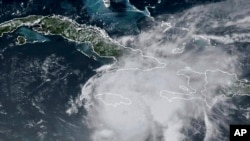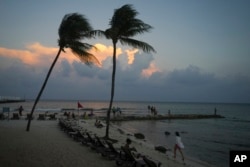The eye of Hurricane Beryl brushed the south coast of Jamaica on Wednesday, whipping the island with high winds and heavy rain for hours. By evening, the country’s prime minister said the country had yet to see the worst of it.
"We can do as much as we can do, as humanly possible, and we leave the rest in the hands of God," Prime Minister Andrew Holness said.
The storm knocked out power to Kingston and some communities on the northern part of the island, thanks to downed utility poles and trees.
Before Beryl, a Category 4 storm that has so far killed seven people, arrived in Jamaica’s capital city, people could be seen boarding windows and pulling boats from the water.
"There are going to be multiple life-threatening hazards that are going to play out over the next 6 to 12 hours across Jamacia," said U.S. National Hurricane Center Director Michael Brennan.
Conditions include strong wind gusts and storm surge of 0.3 to 2.7 meters over typical tides with possible destructive waves atop it. Ten to 20 centimeters of rain will pelt most of the country, maxing at 30 centimeters in some areas, which could cause mudslides and flash flooding.
"Plan to shelter in place for the remainder of the day well into tonight," Brennan added for those living in Jamaica.
"Jamaica must take this hurricane seriously. I am now declaring the whole of Jamaica to be a disaster area … for the next seven days," Holness, the prime minister, said in a video posted on X.
An island-wide curfew was to be imposed. And an evacuation order was issued for flood- and landslide-prone parts of the country.
The NHC says Hurricane Beryl has maximum sustained winds of 230 kph, making it a Category 4 storm on the center’s five-level scale that measures a storm’s maximum sustained wind speed and destructive potential. The storm has hurricane-force winds up to 75 kilometers from its center and tropical-storm force winds up to 295 kilometers from the center.
At last report Beryl was located just offshore of the southwest part of Jamaica.
Hurricane warnings are in effect for Jamaica and the islands of Grand Cayman, Little Cayman and Cayman Brac, while hurricane watches are in effect for Haiti and the Dominican Republic, which shares the island Hispaniola, and Mexico’s Yucatan peninsula, where forecasters believe Beryl will reach by Thursday.
The central American nation of Belize is under a tropical storm watch. Texas may also see some inclement weather.
The Cayman Islands and Yucatan Peninsula will receive 5 to 10 centimeters of rainfall between Thursday and Friday. The hurricane is also expected to trigger dangerous storm surges that could raise water levels between 2 to 3 meters above normal tide levels in Jamaica, and up to one meter above normal tide levels on the Cayman Islands.
The NHC is warning that the southern coasts of Puerto Rico and Hispaniola will experience large swells that could cause life-threatening surf and rip current conditions.
The White House said on its social media account X that U.S. President Joe Biden is closely monitoring Hurricane Beryl and connecting with officials including the U.S. Agency for International Development and the Federal Emergency Management Agency.
Hurricane Beryl has left behind a trail of death and destruction since making landfall Monday on Grenada’s Carriacou island as a Category 4 hurricane with maximum sustained winds of 241 kph. Prime Minister Dickon Mitchell of Grenada says Carriacou and the nearby island of Petit Martinique sustained the brunt of Beryl’s force, with scores of homes and businesses flattened in Carriacou and residents cut off from the outside due to downed power lines and damaged roads.
Among those whose homes were damaged on Carriacou were the parents of Simon Stiell, the head of the United Nations climate change agency. Stiell issued a statement saying, "it’s clear that the climate crisis is pushing disasters to record-breaking new levels of destruction."
Prime Minister Ralph Gonsalves of the archipelago nation of St. Vincent and the Grenadines said Tuesday that 90% of homes on Union Island were destroyed.
Beryl grew from a tropical storm to a major hurricane in 42 hours, which has only happened six times in the recorded history of Atlantic hurricanes. The hurricane is also the earliest to reach Category 4 status in the region and the earliest to reach Category 5 strength. Hurricane Dennis became a Category 4 storm on July 8, 2005.
Beryl is the second named storm in the 2024 Atlantic hurricane season. Tropical Storm Alberto hit northeastern Mexico in June, killing four people.
The National Oceanic and Atmospheric Administration has warned of an above-average hurricane season.
Some information in this report came from The Associated Press, Reuters and Agence France-Presse.










